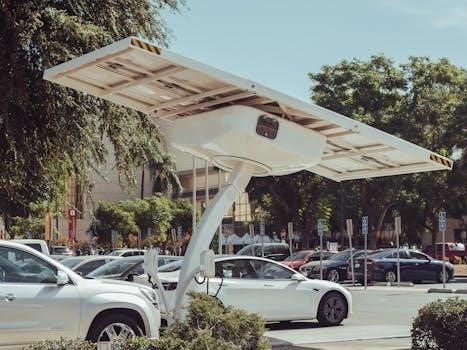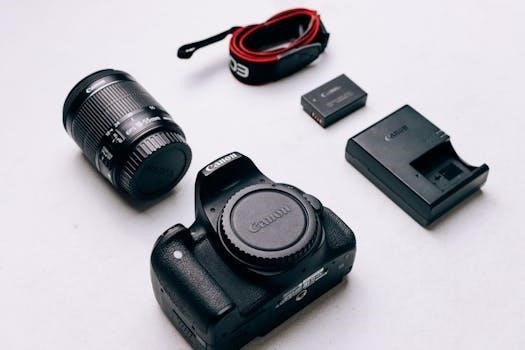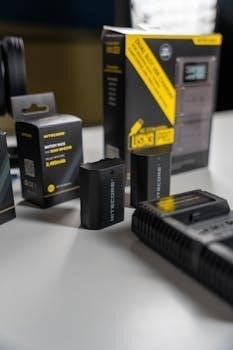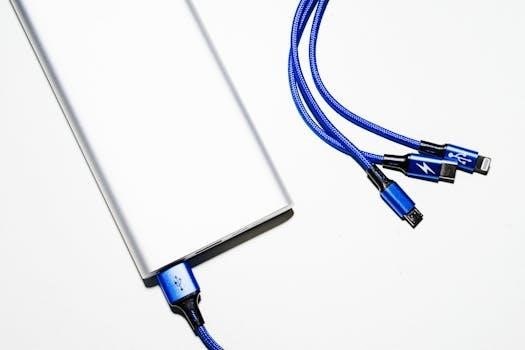DieHard Battery Charger Owners Manual⁚ A Comprehensive Guide
Welcome to the comprehensive guide for your DieHard battery charger. This manual provides essential information for safe and effective use. It covers various models and features, ensuring you get the most from your charger. Read on to discover how to properly maintain and troubleshoot common issues.
Understanding DieHard Battery Charger Models
DieHard offers a range of battery chargers designed for diverse needs, from home use to light commercial applications. Models vary in amperage, voltage, and features, catering to different battery types and charging requirements.
Some models, like the 200.71222, offer 10/2 Amp automatic charging and engine start capabilities. Others, such as the 200.713201, provide 20/15/10/2 Amp fully automatic charging. The 200.713151 is a 15/2/125 Amp model with engine start functionality. Several models include microprocessor control for fully automatic operation, along with battery and alternator testers.
Manual chargers, such as model 28.71221, offer basic charging functions, while fully automatic chargers, like the 200.71223, include features like float-mode monitoring. Some chargers are designed for specific battery types, such as those used in motorcycles, lawn tractors, ATVs, RVs, boats, and snowmobiles.
Understanding the specific model you own is crucial for proper operation and maintenance. Consult your owner’s manual for detailed specifications and instructions tailored to your DieHard battery charger.
Key Features of DieHard Battery Chargers
DieHard battery chargers come equipped with a variety of features designed to enhance their functionality and ease of use; Automatic operation, often microprocessor-controlled, allows for efficient and safe charging without constant monitoring. Many models include engine start capabilities, providing a boost for starting vehicles with weak batteries.
Float-mode monitoring, also known as maintain mode, keeps batteries fully charged by delivering a small current when necessary. This feature prevents overcharging and extends battery life. Battery and alternator testers are integrated into some models, allowing users to assess the health of their battery and charging system.
Multiple charge rate options, such as 2 Amp, 10 Amp, 15 Amp, and 20 Amp, offer flexibility for different battery sizes and charging needs. LED indicators provide visual feedback on the charging status, battery condition, and any potential issues. Safety features, like reverse polarity protection and circuit protection, help prevent damage to the charger and battery.
The rugged and durable construction of DieHard chargers ensures longevity and reliability. Some models also include additional features like air compressors and GFCI outlets, further expanding their utility.

Safety Precautions When Using a DieHard Battery Charger
When operating a DieHard battery charger, strict adherence to safety precautions is crucial. Batteries generate explosive gases during normal operation, so always ensure the charging area is well-ventilated to prevent gas accumulation. Before each use, carefully read and follow all instructions in the owner’s manual.
Wear complete eye and clothing protection when working with lead-acid batteries to guard against acid splashes. Have fresh water and soap nearby in case of accidental contact. Ensure someone is within range of your voice to assist if needed.
Never charge dry-cell batteries commonly used in household appliances, as they may burst and cause injury. Use the charger only on lead-acid type rechargeable batteries. Position the charger’s power cord to avoid stepping on it or tripping over it.
Avoid personal injury by keeping clear of fan blades, belts, pulleys, and other engine parts. Do not allow the charger’s cords to come into contact with the hood, door, or moving engine parts. Always disconnect the charger from the AC power outlet before disconnecting the clamps from the battery.
Operating Instructions⁚ Charging a Battery Inside a Vehicle
When charging a battery inside a vehicle, safety and proper procedure are essential. Begin by ensuring the vehicle is parked in a well-ventilated area to dissipate any explosive gases produced during charging. Locate the battery, typically under the hood or in the trunk, and identify the positive (+) and negative (-) terminals.
Before connecting the charger, ensure the vehicle’s ignition is turned off and all electrical accessories are switched off. Attach the red (positive) clamp of the DieHard battery charger to the positive terminal of the battery. Then, connect the black (negative) clamp to a grounded metal part of the vehicle’s chassis, away from the battery and fuel lines. This helps prevent sparks from igniting any gases.
Select the appropriate charge rate on the charger, typically a lower rate for slow charging and a higher rate for faster charging. Plug the charger into a 120V AC outlet. Monitor the charging process, and once the battery is fully charged, disconnect the charger from the outlet before removing the clamps. Always disconnect the negative clamp first, followed by the positive clamp.
Operating Instructions⁚ Charging a Battery Outside a Vehicle
Charging a battery outside of a vehicle requires a clear, well-ventilated workspace. First, remove the battery from the vehicle, taking care to disconnect the negative terminal before the positive to prevent sparks. Place the battery on a stable, non-conductive surface, away from flammable materials.
Inspect the battery for any visible damage, such as cracks or leaks. If damage is present, it’s crucial to handle the battery with extreme caution and consider professional disposal. Clean the battery terminals with a wire brush to remove any corrosion, ensuring a good connection with the charger clamps.
Connect the red (positive) clamp of the DieHard battery charger to the positive terminal of the battery, and the black (negative) clamp to the negative terminal. Ensure a secure connection by rocking and twisting the clamps. Select the appropriate charge rate based on the battery’s specifications and the desired charging speed. Plug the charger into a 120V AC outlet and monitor the charging process. Once charging is complete, disconnect the charger from the outlet before removing the clamps, starting with the negative clamp.
Selecting the Correct Charge Rate and Battery Type
Choosing the right charge rate and battery type is crucial for efficient and safe charging. DieHard battery chargers often offer multiple charge rates, typically ranging from a slow trickle charge to a faster boost. Selecting the correct rate depends on the battery’s size and condition.

For smaller batteries, like those in motorcycles or lawnmowers, a low charge rate (2-4 amps) is recommended to prevent overcharging and potential damage. Larger batteries, such as those in cars or trucks, can handle higher charge rates (10-15 amps) for quicker charging. However, always consult the battery’s manufacturer specifications for the recommended charging current.
Additionally, ensure the battery type setting on the charger matches the battery you are charging. Most DieHard chargers support various battery types, including standard lead-acid, AGM (Absorbent Glass Mat), and gel batteries. Using the incorrect setting can lead to improper charging, reduced battery life, or even damage. Refer to your battery’s label or the manufacturer’s documentation to identify the correct battery type.
Interpreting Charging Indicators and Status LEDs

Understanding the charging indicators and status LEDs on your DieHard battery charger is essential for monitoring the charging process and ensuring optimal battery health. These indicators provide valuable information about the charger’s operation and the battery’s state of charge.
Typically, a charging LED (often yellow or amber) illuminates when the charger is actively charging the battery. This indicates that the charger is delivering current to the battery and increasing its voltage. The charging LED may blink or change intensity to reflect the charging progress.
Once the battery is fully charged, a “Charged” LED (usually green) will light up. This signifies that the charger has completed the primary charging cycle and has entered a maintenance or float mode. In this mode, the charger provides a small current to keep the battery at its full charge level without overcharging.
Some DieHard chargers also feature error or fault LEDs, which indicate potential issues such as reverse polarity, low input voltage, or a defective battery. Consulting the owner’s manual is important for diagnosing and resolving any issues that may arise during the charging process.
Maintenance and Storage Tips for Your DieHard Charger
Proper maintenance and storage are crucial for extending the life and ensuring the reliable performance of your DieHard battery charger. Regular cleaning helps prevent corrosion and ensures optimal electrical connections. Always disconnect the charger from the power source before performing any maintenance.
Use a dry cloth to wipe down the charger’s housing and cables, removing any dust, dirt, or grime. Inspect the clamps for corrosion or damage, and clean them with a wire brush if necessary. Ensure the clamps are in good condition, as damaged clamps can affect charging performance.
When storing your DieHard charger, choose a cool, dry location away from direct sunlight and extreme temperatures. Avoid storing the charger in damp or humid environments, as moisture can cause corrosion and electrical damage. Neatly coil the cables and secure them to prevent tangling or damage;
Store the charger in its original packaging or a suitable container to protect it from physical damage. Regularly inspect the charger for any signs of wear or damage, and address any issues promptly to maintain its functionality and safety.
Troubleshooting Common Issues
Encountering issues with your DieHard battery charger can be frustrating, but many problems can be resolved with simple troubleshooting steps. If the charger fails to power on, first check the power cord and ensure it is securely plugged into a working outlet. Verify that the outlet is receiving power by testing it with another device.
If the charger powers on but does not charge the battery, inspect the clamps for proper connection. Ensure the clamps are securely attached to the battery terminals, with the correct polarity. Clean any corrosion from the terminals and clamps to ensure a good electrical connection.
Check the charger’s settings to ensure they are appropriate for the battery type and voltage. Incorrect settings can prevent the charger from functioning correctly. If the charger displays an error code, consult the owner’s manual for guidance on resolving the specific issue.
If the battery is not charging, it may be deeply discharged or damaged. Try charging a different battery to verify the charger’s functionality; If problems persist, consider seeking assistance from a qualified technician or contacting DieHard customer support for further troubleshooting.
Warranty and Support Information

Your DieHard battery charger is backed by a warranty, offering protection against manufacturing defects and malfunctions. The specific terms and duration of the warranty may vary depending on the model and date of purchase. Refer to the warranty documentation included with your charger for detailed information.
To make a warranty claim, you typically need to provide proof of purchase, such as a receipt or invoice. Contact DieHard customer support or visit their website for instructions on initiating a claim. Be prepared to describe the issue you are experiencing and provide any relevant details about the charger’s operation.
In addition to warranty support, DieHard offers customer service resources to assist with troubleshooting and general inquiries. You can find answers to frequently asked questions, access user manuals, and contact support representatives via phone or email. Take advantage of these resources to resolve any questions or concerns you may have.
Remember to register your DieHard battery charger online to ensure you receive important updates and notifications regarding product safety and warranty information. By following these steps, you can ensure your DieHard charger remains a reliable tool.
